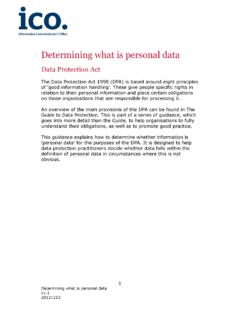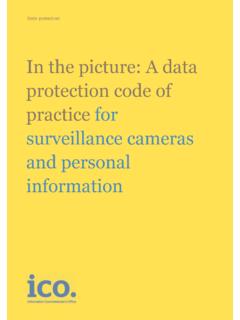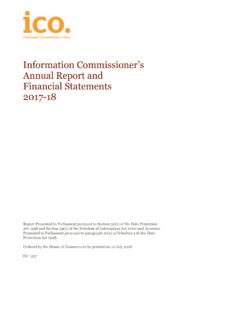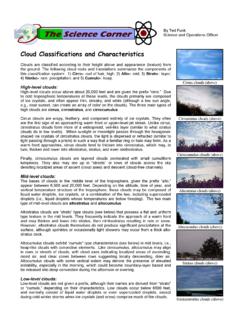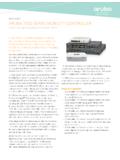Transcription of Guidance on the use of cloud computing - Home | ICO
1 Data Protection Act 1998. Guidance on the use of cloud computing Contents Overview .. 2. Introduction .. 2. What is cloud computing ?.. 3. Definitions .. 3. Deployment 4. Service models .. 5. Layered services .. 6. How does the Data Protection Act apply to information processed in the cloud ? .. 7. Identify the data controller .. 7. Data controller in a private cloud .. 7. Data controller in a community cloud .. 8. Data controller in a public cloud .. 8. Responsibilities of the data controller .. 9. Select which data to move to the cloud .. 9. Assess the risks .. 10. Select the right cloud service and cloud provider .. 11. Monitoring performance .. 11. Informing cloud users .. 11. Get a written contract .. 12. Selecting a cloud provider .. 13. Assessing the security of a cloud provider.
2 13. Protecting your data .. 14. Access 15. Data retention and deletion .. 16. Provider access .. 17. Further 17. Using cloud services from outside the UK .. 18. Multi-tenancy environment .. 20. Reliability and resilience .. 20. Staff training .. 20. Rights of data subjects .. 21. Checklist .. 22. More information .. 23. Guidance on the use of cloud computing 1. 20121002. Version: 1. The Data Protection Act 1998 (DPA) is based around eight principles of good information handling. These give people specific rights in relation to their personal information and place certain obligations on those organisations that are responsible for processing it. 2. An overview of the main provisions of the DPA can be found in The Guide to Data Protection. 3. This is part of a series of Guidance that goes into more detail than the Guide, to help organisations to fully understand their obligations as well as promote good practice.
3 4. This Guidance explains what you should consider prior to a move to cloud computing for the processing of personal data. Overview cloud computing services offer organisations access to a range of technologies and service models typically delivered over the internet. Organisations that maintain and manage their own computer infrastructure may be considering a move to cloud computing to take advantage of a range of benefits that may be achieved such as increased security, reliability and resilience for a potentially lower cost. By processing data in the cloud an organisation may encounter risks to data protection that they were previously unaware of. It is important that data controllers take time to understand the data protection risks that cloud computing presents.
4 This Guidance offers a set of questions and approaches an organisation should consider, in conjunction with a prospective cloud provider, in order to ensure that the processing of personal data done in the cloud complies with the DPA. Introduction 5. A shift towards a greater use of cloud computing is well underway. Innovative products, mobile access to data and affordable pricing structures are often cited as key drivers for an organisation to consider a move to cloud computing . cloud services also offer an affordable route for smaller organisations Guidance on the use of cloud computing 2. 20121002. Version: (including start-up companies) to cope with rapid expansion. The UK government's commitment to adopt greater use of cloud services is demonstrated in the G- cloud programme which has put together a catalogue of cloud information and communications services available to the UK public sector.
5 6. The ICO published the Personal information online code of practice in July 2010. The code explains how the DPA applies to the collection and use of personal data online. It provides practical advice for organisations that do business or provide services online. 7. The Personal information online code of practice briefly discussed the use of cloud computing in relation to processing personal data online. Given the increased usage of this technology the ICO has decided to provide a more comprehensive explanation of the data protection compliance issues that can arise when personal data is processed in the cloud . 8. This Guidance is aimed primarily at organisations using cloud services or considering a move to cloud services it tells them what they need to take into account.
6 9. cloud providers should use this Guidance so that they are aware of the data protection issues that their current and prospective cloud customers may need to deal with. This could help cloud providers to make their services more attractive to customers that are subject to data protection law. What is cloud computing ? 10. cloud computing is a term used to describe a wide range of technologies, so it is important to be clear about what we mean by cloud computing in this Guidance . 11. We use a broad definition of the term in this Guidance in order to cover all the main implementations of cloud computing . Definitions 12. cloud computing is defined as access to computing resources, on demand, via a network. 13. In more detail this covers: computing resources this can include storage, processing and software.
7 Guidance on the use of cloud computing 3. 20121002. Version: on demand the resources are available on a scalable and elastic basis. This typically involves the dynamic provision of virtualised resources. Users are often billed for the level of resource used; and via a network the transit of data to and from the cloud provider. The transit of data may be over a local or private network or across the internet. 14. For further clarity we have defined the three main groups involved in the use and delivery of cloud services. cloud provider The organisation that owns and operates a cloud service (Note: More than one cloud provider may be involved in the supply chain of a single cloud service). cloud customer The organisation that commissions a cloud service for a particular purpose.
8 cloud user The end user of a cloud service for example a member of the public. Deployment models 15. cloud computing can be deployed using a number of different models. Private cloud The cloud customer is the sole user of the cloud service. The underlying hardware may be managed and maintained by a cloud provider under an outsourcing contract. Access to the cloud service may be restricted to a local or wide area network. Community cloud A group of cloud customers access the resources of the same cloud service. Typically the cloud customers will share specific requirements such as a need for legal compliance or high security which the cloud service provides. Access to the cloud service may be restricted to a wide area network. Public cloud The infrastructure, platform or software is managed by the cloud provider and made available to the general public ( cloud customers or cloud end-users).
9 Access to the cloud service is likely to be over the public internet. Guidance on the use of cloud computing 4. 20121002. Version: Hybrid cloud Describes a combination of private, community and public clouds. A cloud customer will segregate data and services across different cloud services, with access between them restricted depending on the type of data they contain. Service models 16. Although the term cloud computing may be applied to a range of technologies there are three main types of cloud service. Infrastructure as a Service (IaaS) An IaaS cloud offers access to the raw computing resources of a cloud service. Rather than purchasing hardware itself, the cloud customer purchases access to the cloud provider's hardware according to the capacity required.
10 Example A software development company is building an application for a client. It needs to test the application before transferring it to the live environment. By using an IaaS cloud service it can simulate an environment which is identical to the live server (except that dummy data will be used) without the need to purchase additional hardware during this relatively short phase of the development process. At the end of the testing process all the data will be deleted from the cloud service and the application delivered to the client. Platform as a Service (PaaS) A PaaS cloud offers access to a computing platform which allows cloud customers to write applications to run within that platform, or another instance of it. The platform may in turn be hosted on a cloud IaaS.
